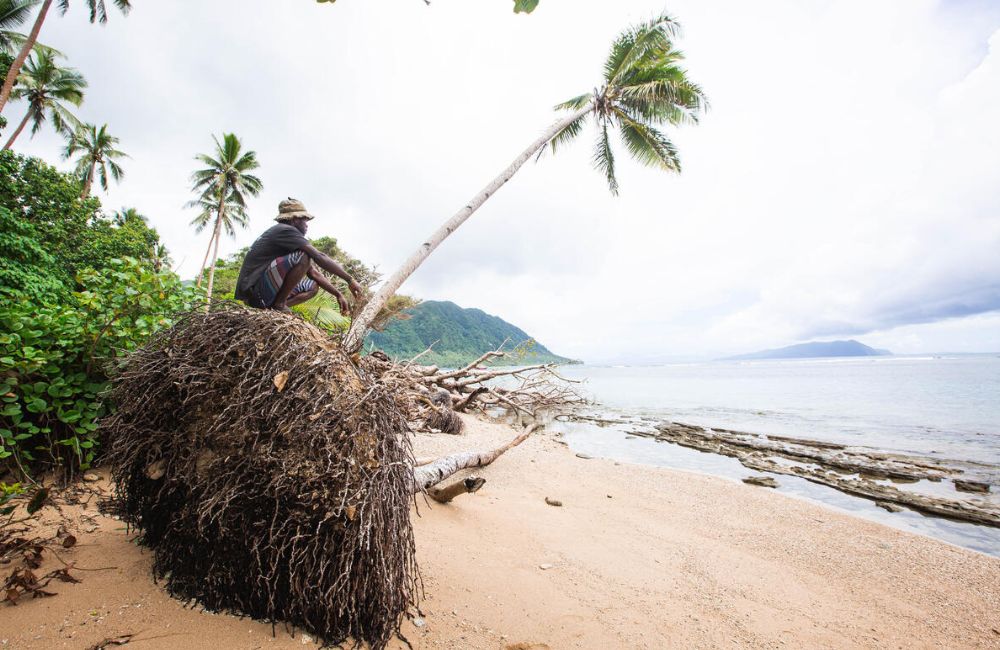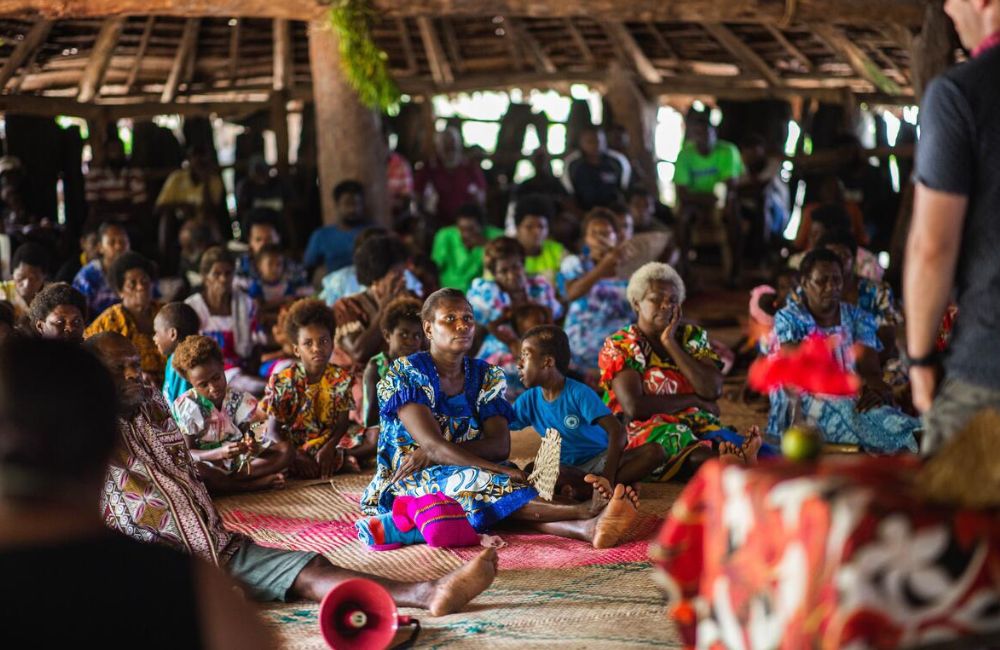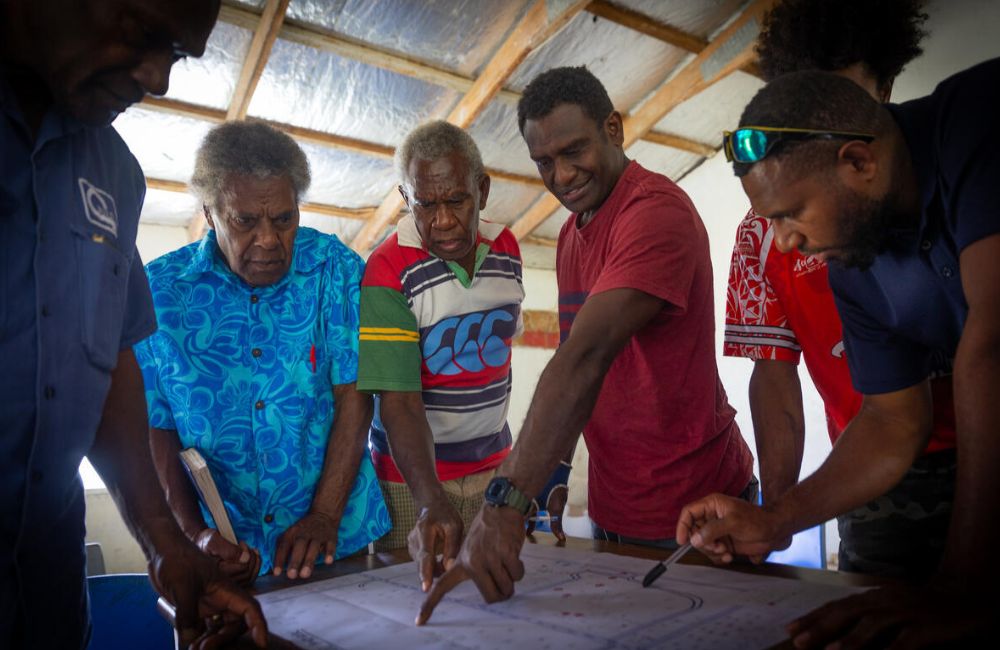This initiative will support over 90,000 people in 282 communities across all six provinces of Vanuatu - nearly half of the country's rural population.
Together, we are committed to helping communities build resilience to climate change and secure a better future for children and young people.
 The VCCRP will reach over half the rural population of Vanuatu and is being implemented in all six provinces.
The VCCRP will reach over half the rural population of Vanuatu and is being implemented in all six provinces.
Strengthening resilience and access to lifesaving information
The first focus of the project is on empowering government, civil society, and communities to build greater resilience to climate change impacts, as well as providing access to crucial climate information and early warnings for disasters and hazards. This is achieved through:
Community-Based Climate Change Adaptation (CCA) and Disaster Risk Reduction (DRR) Mechanisms:
the project is dedicated to building the capacity of local groups, known as Community Disaster & Climate Change Committees (CDCCCs), to effectively address climate-related challenges in their communities.
Increasing Community Understanding: we’re helping communities better understand how climate change is impacting their livelihoods, food security, and sustainable development so they can make informed adaptation decisions. Community understanding will be enhanced by activities like climate change vulnerability assessments, which will inform the development of locally-led adaptation plans.
Enabling Access to Climate Information: the project is supporting the development and upgrade of information systems. Communities need increased access to climate information services so that they can receive early warnings for climate hazards and make better-informed decisions around adaptation.

Vanuatu is at the forefront of the climate crisis and the most vulnerable country to disasters in the world.
Photo: Nikiatu Kuautonga /Save the Children Vanuatu.
Local adaptation to build resilience
The second component focuses on implementing local actions tailored to address community adaptation needs and establish a resilient, sustainable development pathway. This includes:
Nature-Based Solutions: we're improving the resilience of local natural ecosystems to climate change impacts and protecting natural resources (like mangrove forests) from the impacts of climate change.
Climate-Resilient Agriculture: to ensure communities maintain food security and strong livelihoods, the project is helping adapt traditional farming techniques and promoting the use of climate-resilient crops and communal gardens.
Climate-Resilient Fisheries: to further support food security, the project is supporting community-led coastal resource management and fisheries management. This helps coastal communities to withstand the impacts of climate change on vital inshore fisheries resources.
Climate-Resilient Agro-Food Processing: We're scaling up adaptation technologies for food preservation, including the use of solar-powered food dryers and freezers. The project is helping community members to develop food products that can be sold to generate income, particularly through women-led business initiatives.

A community in Vanuatu is consulted on what support they need to adapt to climate change.
Photo: Nikiatu Kuautonga / Save the Children Vanuatu.
Linking systems for sustainability
The third component of the project aims to enhance institutional adaptive capacity by building adaptive governance systems at the local level and strengthening local-provincial-national linkages. Actions include:
Institutional Adaptive Capacity Enhancement: we're strengthening adaptive local governance systems, incorporating climate risk into local development plans, and building the capacity of local authorities to support CDCCCs.
Enhanced Local-Provincial-National Linkages: we aim to ensure that lessons and best practices in climate change flow from the community level to national levels to inform planning and policy development.
These three components collectively form the backbone of the VCCRP, which is designed to build resilience, enhance climate knowledge, and help communities in Vanuatu create sustainable adaptation pathways.
Ensuring sustainability
The VCCRP is the largest investment in locally led adaptation in the world. As well as directly reaching over 90,000 people, the project will also indirectly impact the remaining half of the rural population through increased access to climate information systems and disaster risk reduction outreach activities.
The project is led by the Ministry of Climate Change in Vanuatu with support from Save the Children. The VCCRP is being implemented with other partners such as the Ministry of Internal Affairs, the Ministry of Agriculture, Livestock, Forestry, Fisheries, and Biosecurity, the Ministry of Lands and Natural Resources, and the Ministry of Justice and Community Services.

VCCRP staff practice facilitating a community mapping session with community stakeholders from Ekipe, Efate.
Photo: Nikiatu Kuautonga / Save the Children Vanuatu.
The project will ensure community structures are strengthened and operate effectively with government support, ensuring their longevity well beyond the project's lifespan. Additionally, this project aims to improve the accessibility of climate finance at the community level, reducing bottlenecks at national or provincial levels.
Lessons learned from the VCCRP will be applied to future community-based adaptation projects and widely shared, paving the way for a more resilient and sustainable Vanuatu, today and tomorrow.
Click here for a report on the project’s environmental and social impacts on people and the environment and the measures put in place to mitigate these.
Contact
For further information, contact louise.nasak@savethechildren.org.au.
The VCCRP is primarily financed by the Green Climate Fund, with co-financing from the Department of Foreign Affairs and Trade in Australia and Save the Children, and in-kind support from the Government of Vanuatu.




